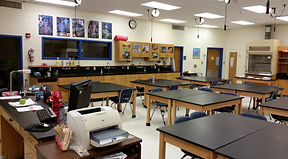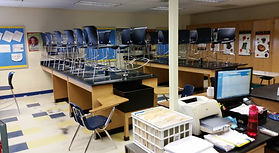About My Classroom
Click the image above to see my Wiki page.

Click the images above to see my AP Biology final example summary report description (top) and rubric (bottom).
I am currently a pre-AP and AP biology teacher at Osbourn Park High School in Manassas, VA. My pre-AP students are in 9th grade, and my AP students are typically in 11th or 12th grade. At our school, pre-AP biology is an honors level introductory course, and both pre-AP biology and pre-AP chemistry are considered prerequisites for taking AP biology.
I maintain a class Wiki page for both of my courses (see image to the left). I use this page to share a detailed course schedule with my students and their parents. I also provide links to most of my course documents and helpful animations/videos (arranged by unit). Overall, my Wiki page has been invaluable for communicating with students and parents, collaborating with other teachers, and maintaining an organized course. This page is private, but you can log in to view the content with the username "portfolio account" and password "teacher".
Unfortunately, I do not have a classroom to call my own because I teach in three different classrooms. In two of these classrooms (see images to the right), the students sit at lab tables that are fixed in rows perpendicular to the teacher desk at the front of the room. In the third classroom (see image to the left), I was able to move lab tables to create pods. I much prefer this arrangement because it facilitates group work. Regardless of the classroom set-up, however, I always place my students into “research teams” consisting of 3-4 people. The students work in these teams for two units of instruction to complete group activities, peer-evaluate each other’s writing assignments, etc. I think this gives them the opportunity to learn to work effectively with a variety of different people.
In my classes, I try to place an emphasis on the development of student critical thinking skills. I frequently have students complete image or data analysis assignments, case studies, lab activities, etc. in service of this goal. If you click the image to the right, it will link to a Google Document with a critical thinking activity that I developed for my freshman biology students. In this activity, students explore what it means to analyze information and apply concepts before attempting an analysis/application activity involving evolution data from HHMI Biointeractive (HHMI, 2016).
When possible, I also incorporate long-term projects that require students to analyze data, synthesize large amounts of information, draw conclusions, and self-assess their work. Currently, my colleague and I are developing a final exam project for our AP students that involves breeding plants and performing genetics experiments. Students will ultimately complete a summary report that allows them to demonstrate their critical thinking skills. If you click the images to the left, they will link to Google Documents related to this report. One of the documents is a description of the summary report requirements, and the other document is a rubric detailing the standards for mastery.
Ultimately, these are just a few examples of the types of assignments that I find to be very meaningful for my students. I have plenty more to share and would be happy to do so upon request. Hopefully, this page gives you a little taste of who I am as a teacher and makes you curious to learn more!


Click the image above to see the evolution critical thinking activity that I designed for my freshmen biology students.



